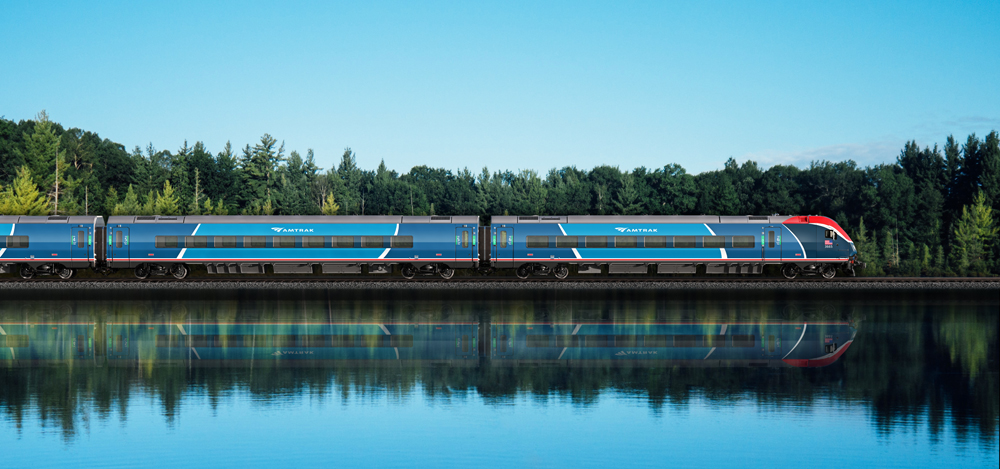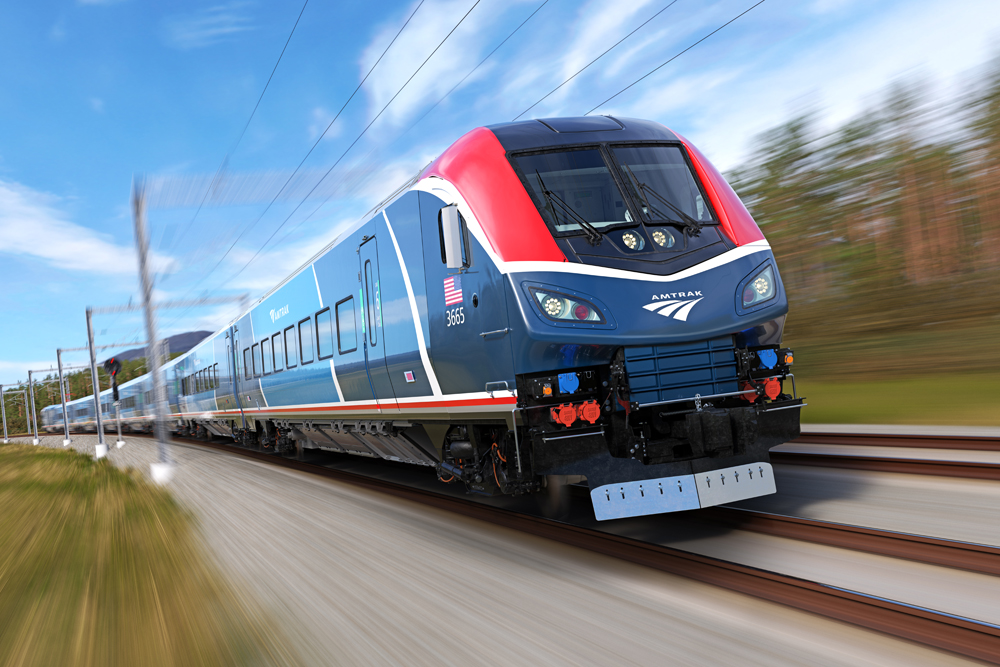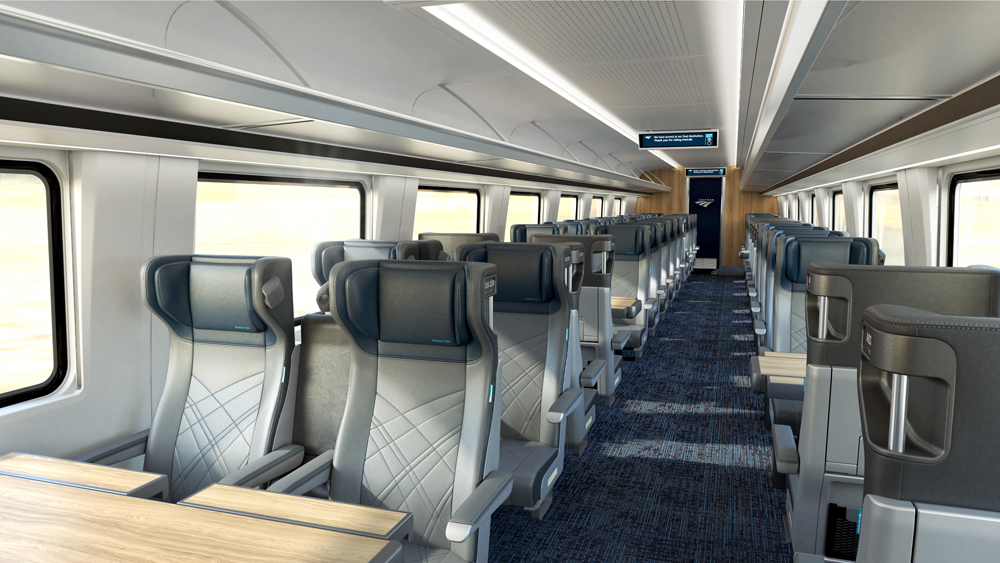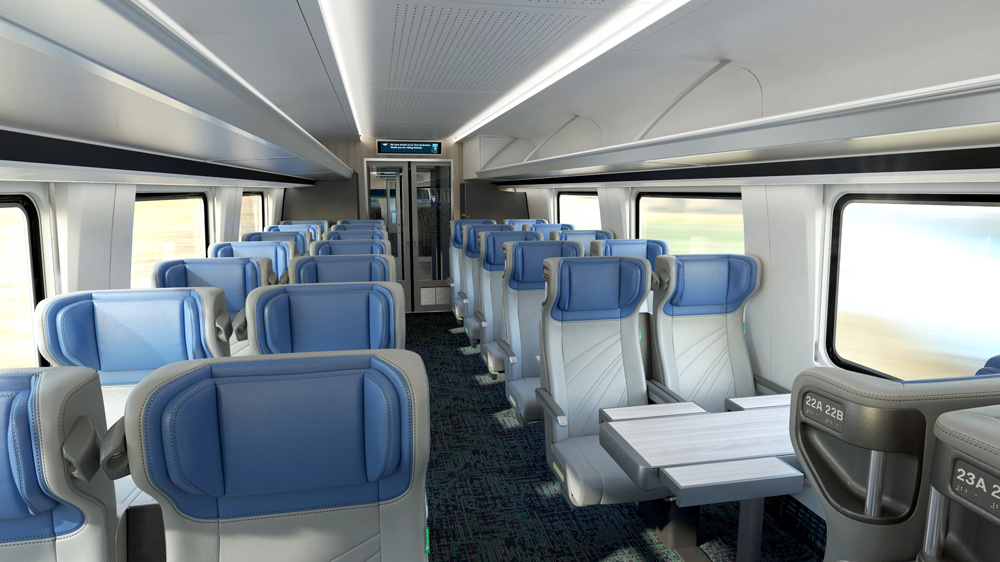
NEW YORK — Amtrak today (Thursday, Dec. 15) introduced the graphics and a new brand name — Airo — for its coming fleet of Siemens Mobility push-pull trainsets due to enter service in 2026, replacing 40- to 50-year-old locomotive-hauled equipment.
At a press conference in Penn Station’s Moynihan Train Hall, Amtrak President Roger Harris and other officials sketched out the broad outlines of an 83-train fleet of semi-permanently-coupled equipment that will operate primarily from Maine to North Carolina and west to Pittsburgh, with some on the West Coast. They will retire the carrier’s iconic but aged Amfleet I cars, Amtrak’s first bought-new rolling stock, which is now nearing 50 years of age, and replace other equipment.

“Amtrak’s procurement of new rolling stock is historic,” Federal Railroad Administration Deputy Administrator Amit Bose said in a prepared statement. “These state-of-the-art trainsets will allow Amtrak to operate and provide services more safely, efficiently, and reliably,”
Entering service first on the Cascades route between Portland, Ore., and Vancouver, British Columbia, Airo trains will resemble Siemens’ Venture coaches now in service or on order for Caltrans, Amtrak Midwest, Brightline, and VIA Rail Canada. The first Airo car shell is under construction at Siemens’ plant at Sacramento, Calif. The production run is estimated to extend into 2031.
The design is based on the Viaggio Comfort fleet of electric-propelled trains operated by ÖBB, the Austrian Federal Railway, according to Steven Morrison, Siemens’ director of business development, passenger mobility systems.

Each push-pull trainset will consist of a power car and six to eight trailing coaches, including a cab control car to eliminate the need for turning. Most will be configured with dual-mode diesel-electric/electric propulsion to facilitate no-engine-change service to and from electrified territory in the Northeast Corridor and Keystone Corridor. They will reach a top speed of 125 mph.
The 83 trainsets comprise 73 dual-mode versions costing about $3.4 billion, with another 10 sets costing $1.5 billion. Seventeen of the sets for Empire Service will employ hybrid battery technology. In all, the contract is worth $7.3 billion, including spare parts and a continuing service agreement. The deal leaves the door open for an additional 130 trainsets if Amtrak’s expansion plans come to pass.
Eventually, Airo trains will be deployed on both Amtrak and state-supported short- and medium-haul trains, including the Adirondack, Carolinian, Downeaster, Empire Service, Ethan Allen Express, Keystone service, Maple Leaf, New Haven-Springfield service, Northeast Regionals, Palmetto, Pennsylvanian, Vermonter, Valley Flyer, and Virginia services.

Harris said Airo equipment “combines new features with the traditional values” of train travel. He cited lower environmental impact through reduced emissions, as well as faster schedules due to reduced dwell times at stations where diesel and electric locomotives now change at the end of catenary.
Harris listed passenger amenities including panoramic windows, ergonomically designed seats, adjustable headrests, at-seat charging ports, and dedicated cup and seatback tablet holders. He said the trains will offer “contemporary food service” that will include self-serve options, though he quickly added that this does not mean vending machines. The cars will provide digital signage and full accessibility to comply with provisions of the Americans with Disabilities Act.
Harris told Trains News Wire that the Airo name was “one of many that our advertising agency proposed. Airo has aerodynamic implications, it has some alliteration with [the words] Amtrak and Acela, and it has some Amtrak history — the [1971] arrow logo.”
Morrison explained that, in electrified overhead territory, the dual-mode trains will be configured with a single pantograph mounted on a business-class coach that will feed current from catenary to the power car. Asked if the application of dual-power propulsion to a semi-permanently coupled trainset is new, he said that this is an entirely new technology mix that does not exist elsewhere.
On the issue of capacity constraints and lack of flexibility for high-demand periods that is posed by a fixed-consist approach, Harris said Amtrak would simply add another frequency. Currently, when extra coaches are available, Amtrak couples extra cars to peak holiday trains as needed.
That will still be possible with Airo trains, according to Ray Ginnell, Siemens’ vice president for commuter, regional, and passenger coaches, but it’s more complicated. Adding or deleting cars from a consist can be done, he said, but only in a shop, not at a station or yard. Airo trains can run up to 10 cars long, he added.
Editor’s note: The 83-trainset figure in this article includes an option for 10 trainsets that was exercised in August 2023 (see “Amtrak exercises contract option …,” Trains News Wire, Aug. 21, 2023], although that was not reported at the time.














They want dual-mode power units to eliminate the “time consuming” engine change. But we all know a southbound train for Richmond will still sit at D.C. union station for a half hour…………
I have 2 issues here, both of which I’m clearly not the only person concerned. An apparent inability to make trains longer or swap out cars or locos when needed is a major problem. Especially when we see major reliability issues sidelining an entire train for something ‘minor’ in one car, or we can’t swap out a problematic loco.
Although Siemens is a Germany Company, the railway equipment that it sells to Amtrak is make in this country. It is not cheap foreign stuff, unless you consider California to be a foreign company. Siemens employs nearly 40,000 people in the U.S.
As is true for most new equipment, the Airo train sets will have teething problems. Most of them will be resolved. The train sets probably will generate a good outcome for corridor operations, which is where passenger trains make sense.
The long-distance trains make no economic sense. Buying new equipment for them would be throwing good money after bad. The best outcome would be to discontinue them, and convert those segments of the long-distance routes into high frequency corridors where it makes sense, i.e., DFW to San Antonio, DFW to Houston, Tucson to Phoenix, etc.
Rants against Amtrak’s management server no useful purpose. If people disagree with their policies, procedures, or practices, state the issue without the personal belittling.
Long distance is NOT about making money, but rather providing a viable transportation method to people in places where there is little or no air service, or where many don’t fly, or rail is more reliable. Just because Amtrak has been doing such a bad job of it doesn’t mean we don’t need it.
“unless you consider California to be a foreign company.”
It may as well be. And I live here in California….
Don’t be surprised Mr. Rice if that’s exactly what happens mirroring the Venture cars. There seems to be an unholy alliance between Amtrak and Siemens (SC44s, ALC42s, the Ventures, and now this. And all the first three have had troubled starts resulting in train cancellations and significant delays to trains out on the road and even on the Chicago Terminal. And there was the sleazy, slimy debut of the first ALC42 on Train #7 at CUS. And it seems no one, not Amtrak, not ILDOT, not MIDOT, not Siemens itself, has been called to account.
To this day I still see cars lettered “BURLINGTON” in regular service on METRA BNSF. There hasn’t been a Burlington since 1970, but the cars are older than that, dated to I believe around 1964. Which is 58 years ago.
I won’t be around in 58 years, so I’ll never know ….. if cars now being built and purchased by Amtrak will last 58 years.
I have a bad feeling about this. Siemens says dual-power propulsion on a semi-permanently coupled train set is an entirely new technology mix that does not exist elsewhere. Many things with serial number 1 don’t work as advertised for a long time, and some never work as expected. I also thought railroads learned from the FT and the early Zephers that semi-permanently coupled equipment sidelines the entire consist for one minor problem like a clogged toilet. And adding extra trains instead of extra cars for surge capacity requires more crews, and outside the NEC more available track capacity. But then again, Amtrak management does not think like a railroad these days.
It seems like here in America, we have to depend on foreign builders and manufacturers to build new passenger cars and locomotives for our railroads and Amtrak. Whatever happened to the saying “Built in America” ? The old car builders like Pullman Standard, Budd , ACF and others built quality made equipment that was reliable, dependable and durable and ran for years on our nation’s lines. The present equipment running on Amtrak such as the Amfleet cars and Superliner cars are still providing good service and standing in the gap until these new Siemens cars come on line. The Amfleet coaches are over 40 years old nearing the half century mark and maybe beyond. I bet these new Siemens cars won’t even last 25 years before they too will need to be replaced by some other poor, cheap quality foreign product. But this how things operate in America we boast and talk about how great we are and want to claim to be the world’s greatest nation but we don’t back up that claim. We don’t build or create anymore we import and buy other nations products and goods instead and not of good quality or durability
Joseph C. Markfelder
JOSEPH —- I wish I could say you are overstating your case. You are NOT overstating your case. You’re right on the mark.
Compare the ex-Canadian Pacific Budd fleet which seems to finally be deteriorating after all these decades …. to VIA’s Renaissance Fleet that was cast off from Europe.
From the graphic, it appears some of the Business-Class seats are rear-facing.
Will the cars have usable steps for low-level platforms?
Does anyone know how to pronounce “Airo”? This crap is just so Stephan Gardneresque. He and his merry band just couldn’t give this eq, if it ever sees the light of day in efficient, trouble-free revenue service, a name that sounds like passenger train. Oh, and you all ought to read NARP/RPA President, James Mathews, absolutely gush on this eq after touring a mock up in Penn Station NY. I mean it was stomach-churning. On and on he went bragging how the interior appointments were the result, at least in part, to RPA input. Listening to him, all is forgotten. The October 2020 “massacre” of employee layoffs, eq mothballing, and LDs being cut to tri-weekly. The short consists, fares going through the roof, cancellations of PRIIA209 trains for lack of eq and/or crews. Management bonuses in a public agency utterly dependent on state and federal subsidies. I hope he and all all the top folks at RPA and their state affiliates crap in their pants when Gardner again starts reducing LD frequencies account lack of serviceable eq.
For what it’s worth, I pronounce ‘Airo’ as ‘air-oh’.
these new train sets sure look sleek but I’ll miss the amfleet cars and talgo trains
If no new LD train equipment Amtrak can always just hand down the displaced Amfleet-1s. There might be future congressional demand for more LD trains so where else where does the equipment come from? This smacks of too much NEC emphasis.
I love that Amtrak is ordering new equipment and I think they are on the track here. However, two concerns: 1) Not being able to easily add or remove coaches seems like a bike mistake (especially when you need to swap equipment on different trains and the demand on different corridors is so different – much less flexibility); 2) Are the seats reversible? Being able to go the other direction without turning the train around is great, but not if half the customers have to ride backwards for a 5 hour train ride. Also, I agree with Mike, when is the new equipment for LD trains coming? Amtrak is one more derailment away from having to cancel trains simply due to lack of Superliner equipment – this needs to be ordered yesterday.
Pointless Airo? Arrowless Airo?
what about all the acs-64’s
or do they expect they will will be toast
The ACS-64 fleet will be at or near 20-years old by the time all the Airo sets are in service. A few are already on lease to MARC. The LDs will still use conventional electrics north of DC.
Did anyone stop to think that “Airo” sounds like “Aero”, which is how I get around these days instead of Amtrak.
Its close to “Aire”. which in Spanish means “air”. E.g. Buenos Aires.
In Amtrak’s case, until they are built, no “bugs” identified, placed into service and working, hopefully this will not be a lot of “hot air”.
Yet we are told that we won’t see any new long distance equipment until 2030?
Because Gardner and Coscia, the latter given yet another term as Board Chair thanks to behind-the-scenes maneuvering by the great liberal hope, NY Sen. Charles Schumer, do not want to operate the LDs. They will kill them off by a thousand cuts and Congress will never notice until, “What, “my” LD train is gone? But, but, but we told Amtrak…”.
OK. Branding means nothing without reliable, quality service. And, will this Siemens order work any better than the current stuck in roll-out without any success?
I was thinking the same thing. Will the passenger cars get stuck in operations purgatory because Siemens used the wrong piping material in the lavatories and it takes 20 unions approval to get the piping replaced?